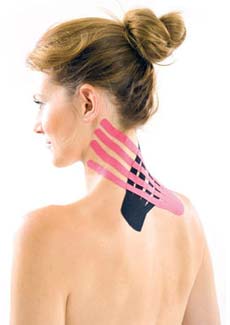|
|
Kinesio Tape: a Support for Aching Muscles and Joints

A safe medical tape made of elastic, vented high-quality, raw material
aiming to provide excellent comfort, immobilization and stabilization while it
helps prevent some acquired disease from its second treatment around the skin.
It is made of durable, breathable padded material for maximum wear and comfort.
Developed by a Japanese doctor over 30 years ago has recently become popular
among sports persons-- athletes like German beach volleyball player Katrin
Holtwick use it. In black, pink, blue and beige, the tape has been spotted on a
number of Olympians, including the shoulder of U.S. water polo player Lauren
Wenger and the elbows of Canadian Greco Roman wrestler Ari Taub. Members of
Spain�s basketball team and Jamaica�s track team. The tape separates the upper
layer of the skin from muscle tissue. This extra space allows for muscles to
fire and recover more quickly.
In July, the Journal of Orthopaedic & Sports Physical Therapy published a study
of 42 people with shoulder
injuries.
Half of them were treated with Kinesio tape applied in a pattern designed to
support the injured muscle.
The other half were given a �sham� treatment in which two strips of tape were
simply pressed across the arm. The study was conducted by physical therapists at
Winn Army Community Hospital in Fort Stewart, Ga., who didn�t receive funding
from the tape company. Notably, the study participants who received the real
therapeutic tape treatment reported an immediate improvement in pain.
Features of original kinesiology tape
Kinesio Tape is a cotton tape which comes in various widths, the most common
being 5cm (2 inches). It comes in a variety of colours, Beige, Pink, Blue and
Black, with features like,
-
Comfortable to wear by high-quality cotton fabric
-
Similar elasticity to skin and muscle
-
Ventilation for skin breathing
-
Water-resistant in pool and shower
-
Excellent adhesive durability
�This tape moves with the body, so the biomechanics are still there,� said John
Jarvis, director of Kinesio USA. The effect of this tape is to create a bridge
over the areas that are injured so that athletes can perform sport movements and
have either prophylactic support or support to an injured part of the body.
How to Apply
 Initially the tape needs to be applied by a CKTP (Certified Kinesio Taping
Practitioner) after assessment and discussion between the expert and user to
decide whether it is appropriate to to use. The CKTP will also direct you as to
where you can buy the tape. Initially the tape needs to be applied by a CKTP (Certified Kinesio Taping
Practitioner) after assessment and discussion between the expert and user to
decide whether it is appropriate to to use. The CKTP will also direct you as to
where you can buy the tape.
CKTP Training is undertaken at 3 levels and when level 3 is completed and after
passing a written exam. The practitioner will have the letters CKTP after their
name, standing for Certified Kinesio Taping Practitioner, and should be
registered with the KTA (Kinesio Taping Association).
The more that these areas in the brain are activated by meditation the more
that
pain was reduced. One of the reasons that meditation may have been so
effective in blocking pain was that it did not work at just one place in the
brain, but instead reduced pain at multiple levels of processing.
Benefits of a kinesiology tape
-
Increase body natural healing power
-
Reduce muscle fatigue and recover muscle and joint injury
-
prevent muscle and joint injury
-
Improve blood, lymph and fluid circulation
-
Reduce neurological pain
The tape support muscles and joints without disturbing the blood flow of the
body. Different techniques are used for applying the tape in different areas
of the body and for what is affecting each area. While the application and prep
is always the same, the reason for taping will vary. This tape is widely used
in pediatric physical therapy for muscle disorders like cerebral palsy.
Currently, there is not a lot of research indicating that kinesio tape actually
works -- but if athletes believe it helps, that in itself might be enough.
For more:
Dated 13 August 2012
Related Links
|
|
|
|
|
|
|









